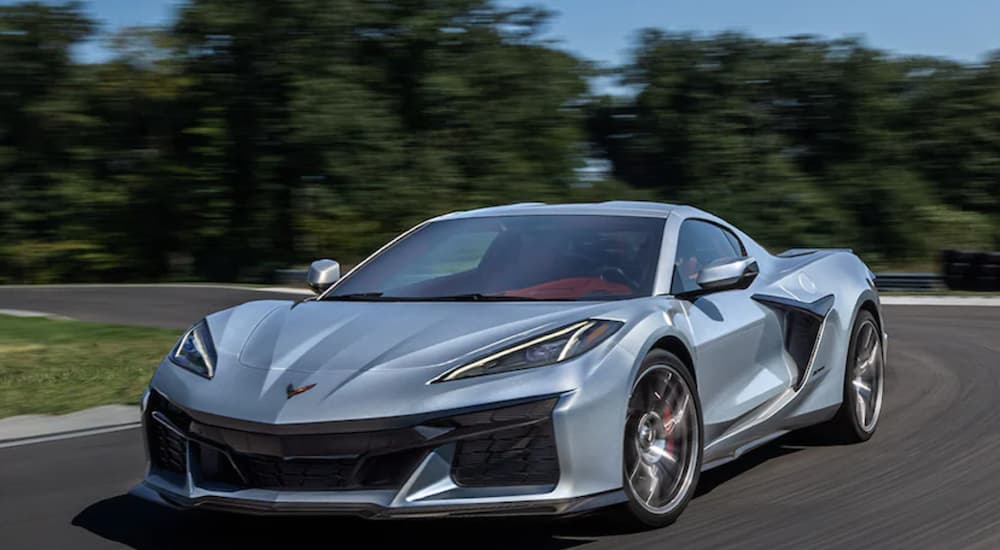If you’ve only ever seen a Corvette on a cantered podium in a Chevrolet dealer showroom, you’ve likely wondered just how fast it can go when it’s off the blocks and in its element—and the answer is pretty darn fast. With a rich history firmly rooted in racing, the Corvette has proven itself time and time again at some of the most famous races in the world. One such race is the infamous 24 Hours of Le Mans, one of the most anticipated races in the world. Hundreds of thousands of like-minded car aficionados are drawn together each year to watch in wonder as drivers from all over the world are pushed to their limits. This test of endurance and speed pits only the best cars and drivers against one another in an awe-inspiring feat of perseverance.
For over sixty years, the Chevy Corvette has been amongst those deemed worthy enough to compete, taking home eight wins thus far. Stretching as far back as the sixties, Chevy has been proving its grit on the Circuit de la Sarthe racetrack, cementing itself into Le Mans racing history. Those wins did not come without encountering a few speed bumps along the way, but, in the words of Theodore Roosevelt, “Nothing in the world is worth having or worth doing unless it means effort, pain, difficulty….” This would become an integral sentiment toward the Corvette’s climb to the top and how it changed the role of American sports cars at Le Mans.
Challenging Misconceptions
The story of how the Chevrolet Corvette first found itself participating in the 24 Hours of Le Mans actually all starts with a man named Briggs Cunningham. A millionaire racing enthusiast, Briggs Cunningham was no stranger when it came to the Circuit de la Sarthe racetrack. As a racer at heart, Briggs had but one goal: to race at Le Mans. However, Briggs didn’t just want to race at Le Mans—he wanted to win, and he wanted to do so in an American-made sports car.
Now, the idea of racing an American-made sports car probably doesn’t sound far-fetched today, especially when you consider that we are currently staring down the front end of a Corvette E-Ray that goes zero to sixty in 2.5 seconds and produces 655 hp. However, not too long ago, the idea of a sports car built by a Yank that could hang with the European “big dogs” seemed nearly impossible. In fact, it was almost laugh-worthy. But that didn’t stop Briggs from trying.
After a few failed attempts, Briggs Cunningham set his sights on the Corvette, and he did this without the backing of Chevrolet. Why Briggs entered without the checkered flag from GM is neither here nor there, but their restraint from the event did not stop them from looking on with pride as one of their newest creations hit the slick road of Circuit de la Sarthe. And it wasn’t just one, but THREE of their creations entering that race and taking on the stigma surrounding American-built race cars.
The first three Corvettes to enter the 1960 Le Mans were bought at a local dealership and were then modified to the hilt. Briggs filled the seats with some of the best American drivers he could find, including himself, and there were two men to each Corvette: in the No. 1 car was Briggs and his co-pilot, William Kimberly; in the No. 2 was Fred Windridge and Dr. Dick Thompson, who was aptly nicknamed “The Flying Dentist” (which is a story for another time); and in the No. 3 was Bob Grossman and John Fitch.
After some intense testing, it was off to the races. Each of the Cunningham Corvettes proved essential in the race and in changing perceptions of American-built sports cars. However, only one would come out victorious and claim the win for its class. Each Corvette fell numerically, with the No. 1 Corvette calling it near the beginning and the No. 2 Corvette reaching for the finish line but, unfortunately, falling short.
Despite some mechanical issues, the No. 3 Corvette persevered, largely thanks to the clever thinking of the Cunningham team. As the No. 3 team pushed the Corvette past overheating and frequent pit stops, it became abundantly clear that the Corvette had what it took to keep up. In the end, the Chevy Corvette took first in its class and an overall win of eighth place. Cunningham’s determination to push the Corvette to its limits had motivated Chevrolet—and other American automakers—to push their limits as well.
Corvette Racing at Le Mans
In 2000, Corvette Racing set out to conquer Le Mans, picking up where Briggs Cunningham had left off some forty years prior. Their first Le Mans race, which would be completed with two C5-R Corvettes, did not end with a victory—and yet this was far from a setback. Instead, the loss further fanned the flame of determination, a fitting metaphor if you consider the conditions surrounding that first Le Mans run.
When Corvette Racing returned to Le Mans in 2001, they returned as winners, which gave them the edge they needed to claim their first official win on the Circuit de la Sarthe racetrack. In the following years, Corvette Racing would celebrate several 1-2 finishes, proving that luck had nothing to do with it. By 2011, Corvette Racing had seven Le Mans wins under its belt. As of this article, their most recent win was in 2015, bringing the grand total up to eight wins for Corvette Racing and nine for the Chevy Corvette.
Where Track Meets Road
One of the guiding principles of Corvette Racing is technology transfer. This concept focuses on taking performance technology developed by the motorsport segment and applying it to vehicles designed for the road. A prime example of this is the Chevy Corvette Z06. Almost ten years ago, Chevy displayed their Corvette C7.R race car, which shared many similarities with the Corvette Z06 road car. It was actually the C7.R that was taken to Le Mans in 2015, bringing home Chevy’s latest win.
The C7.R was Chevy’s first official GTE Pro Class win; considering this victorious vehicle was the influence behind the Corvette Z06 road car says a lot about the expected performance capabilities of the Z06. Fast-forward to today and the new Z06 looks and acts like a race car, leading you to question if it’s 100% street-legal; despite appearances, however, the Corvette Z06 is very much street-legal and is an incredible example of what’s possible.
Gone Tomorrow, Here Today
It seems safe to say that everyone who made it possible for the first Corvette to strut its stuff down Circuit de la Sarthe more than sixty years ago has, in some small part, contributed to where the Corvette is today. If it wasn’t for the determination and ingenuity of Cunningham and his team, the Corvette may have died on that track, never seen for what it could become. Instead of the sleek and stunning Corvette we are all familiar with, we could be in a world where the Corvette is nothing more than a “bathtub on wheels.”
This inspiring journey is a great reminder that everything has to start somewhere and, more than likely, that somewhere was someone’s imagination. Being able to see the potential in something—especially when others don’t—is perhaps one of the greatest gifts of all. From Cunningham to the first Corvette Racing team to the Chevy designers and engineers of today, all have contributed to one of the greatest American sports cars ever to grace the pavement.




